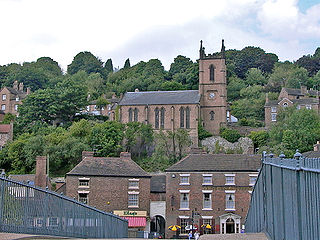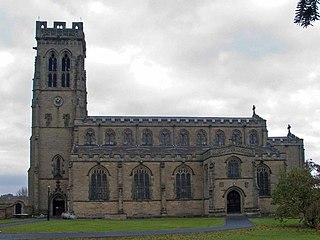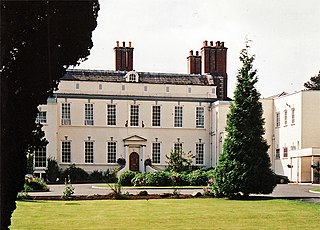
Shropshire is a ceremonial county in the West Midlands of England, on the border with Wales. It is bordered by Cheshire to the north-east, Staffordshire to the east, Worcestershire to the south-east, Herefordshire to the south, and the Welsh principal areas of Powys and Wrexham to the west and north-west respectively. The largest settlement is Telford, while Shrewsbury is the county town.

Ironbridge is a riverside village in the borough of Telford and Wrekin in Shropshire, England. Located on the bank of the River Severn, at the heart of the Ironbridge Gorge, it lies in the civil parish of The Gorge. Ironbridge developed beside, and takes its name from, The Iron Bridge, a 100-foot (30 m) cast iron bridge that was built in 1779.

Telford is a town in the Telford and Wrekin borough in Shropshire, England. The wider borough covers the town, its suburbs and surrounding towns and villages. The town is close to the county's eastern boundary, and near the River Severn. The notable hill near the town called The Wrekin is part of the Shropshire Hills, an Area of Outstanding Natural Beauty. To the south of the town is the Ironbridge Gorge, a UNESCO World Heritage Site. Places around the Ironbridge Gorge area, which were developed into the town itself, are internationally recognised as being "The Birthplace of Industry" being to a large extent constructed during the Industrial Revolution on the Shropshire Coalfield. The town is the main administrative centre for Telford and Wrekin Council.
Baron Forester, of Willey Park in the County of Shropshire, is a title in the Peerage of the United Kingdom. It was created on 17 July 1821 for Cecil Weld-Forester, who had previously represented Wenlock in the House of Commons. Born Cecil Forester, he assumed the additional surname of Weld by royal licence in 1811. His son, the second Baron, also represented Wenlock from 1790 in Parliament, and later served in the Tory administration of Sir Robert Peel as Captain of the Honourable Corps of Gentlemen-at-Arms from 1841 to 1846.

Coalbrookdale is a town in the Ironbridge Gorge and the Telford and Wrekin borough of Shropshire, England, containing a settlement of great significance in the history of iron ore smelting. It lies within the civil parish called the Gorge.

Wellington is a market town and a civil parish in the borough of Telford and Wrekin, Shropshire, England. It is situated 3 miles (4.8 km) northwest of Telford and 12 miles (19 km) east of Shrewsbury, near the western terminus of the M54 motorway. The summit of The Wrekin lies 3 miles to the southwest. Wellington’s population was 25,554 in the 2011 census.

Much Wenlock is a market town and parish in Shropshire, England; it is situated on the A458 road between Shrewsbury and Bridgnorth. Nearby, to the north-east, is the Ironbridge Gorge and Telford. The civil parish includes the villages of Homer, Wyke, Atterley, Stretton Westwood and Bourton. The population of the civil parish, according to the 2001 Census, was 2,605, increasing to 2,877 by 2011.

Craven Arms is a market town and civil parish in Shropshire, England. It is sited on the A49 road and the Welsh Marches railway line, which link it north and south to the larger towns of Shrewsbury and Ludlow respectively. The town is enclosed to the north by the Shropshire Hills Area of Outstanding Natural Beauty and to the south is the fortified manor house of Stokesay Castle.
Shropshire was established during the division of Saxon Mercia into shires in the 10th century. It is first mentioned in 1006. After the Norman Conquest it experienced significant development, following the granting of the principal estates of the county to eminent Normans, such as Roger De Montgomery and his son Robert de Bellême.

Broseley is a market town in Shropshire, England, with a population of 4,929 at the 2011 Census and an estimate of 5,022 in 2019. The River Severn flows to its north and east. The first iron bridge in the world was built in 1779 across the Severn, linking Broseley with Coalbrookdale and Madeley. This contributed to the early industrial development in the Ironbridge Gorge, which is now part of a World Heritage Site.

Madeley is a historic market town and civil parish in the borough of Telford and Wrekin, Shropshire, England. The parish had a population of 18,774 at the 2021 census.

Madeley Old Hall is a black and white Elizabethan house, now a small hotel, in the village of Madeley in Staffordshire, England. It stands in 2 acres of landscaped gardens and is a Grade II* listed building.
Haberdashers' Abraham Darby Academy in Telford, Shropshire, England, is a coeducational secondary school on Ironbridge Road in Madeley which was founded in 1937. It is named after Abraham Darby III and is situated one mile from the Iron Bridge which he built in 1779. In September 2008 the school was converted to an academy through a link to Haberdashers' Adams, and was accepted by the Department for Children, Schools and Families (DCSF). The school is a subsidiary of Haberdashers' Adams Grammar School in Newport. It part of the HWMAT group of schools. The new-style-academy is sponsored by the Worshipful Company of Haberdashers'.

Woodside is a residential area within the civil parish of Madeley in Shropshire, England. It is also the name of an electoral ward of both Madeley Town Council and the borough of Telford and Wrekin. The population of the borough ward at the 2021 Census is given as 7,597.

Haughton Hall is an early 18th-century country house situated at Haughton Lane, Shifnal, Shropshire, England now converted for use as a hotel. It is a Grade II* listed building.
Abraham Darby IV was an English ironmaster.
Revd. Charles Richard Ball was the leading trustee and reputed Lord of Madeley Manor. In Peterborough, he was the Vicar of St Paul's Church and the Honorary Canon of Peterborough Cathedral.
Madeley is a town and a civil parish in the district of Telford and Wrekin, Shropshire, England. It contains 54 listed buildings that are recorded in the National Heritage List for England. Of these, one is listed at Grade I, the highest of the three grades, seven are at Grade II*, the middle grade, and the others are at Grade II, the lowest grade. Most of the listed buildings are grouped in or near the town centre, and these include houses and cottages, the earliest being timber framed, two larger houses with associated structures, churches, a presbytery, a school, and a war memorial. To the north of the town centre is Madeley Court, now a hotel, which is listed together with associated structures. Outside the town centre are more listed houses, two public houses, and former industrial structures, including an inclined plane, a bridge, and the remains of a brickworks and an ironworks, the latter two forming part of the museum at Blists Hill Victorian Town.

St Mary's Church is a Roman Catholic church located on the corner of the High Street and Hanover Close in Madeley, Shropshire, England. It was built from 1852 to 1853 and was designed by Joseph Hansom in the Gothic Revival style. English Reformation

Holy Trinity Church is an Anglican church in Coalbrookdale, Shropshire, England. It is part of the United Benefice of Coalbrookdale, Ironbridge and Little Wenlock, in the Diocese of Hereford. The building is Grade II* listed.















